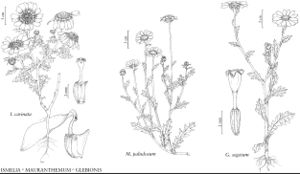Ismelia
in F. Cuvier, Dict. Sci. Nat. ed. 2, 41: 40. 1826.
| Taxon | Illustrator ⠉ | |
|---|---|---|
 | Ismelia carinata Mauranthemum paludosum Glebionis segetum | Yevonn Wilson-Ramsey Yevonn Wilson-Ramsey Yevonn Wilson-Ramsey |
Annuals, 10–30 (–50+) cm. Stems 1, erect, usually branched distally, glabrous or sparsely hairy (hairs basifixed). Leaves mostly cauline; alternate; petiolate or sessile; blades obovate to oblong (bases sometimes clasping), usually 2-pinnately lobed, ultimate margins usually dentate, rarely entire, faces glabrous. Heads radiate, borne singly or in 2s or 3s. Involucres hemispheric or broader, 12–25+ mm diam. Phyllaries persistent, 20–30+ in 2–3 series, distinct, ovate or obovate to lance-deltate or lanceolate (± carinate), unequal, margins and apices scarious (tips of inner often ± dilated). Receptacles convex to conic, epaleate. Ray-florets 13–21+, pistillate, fertile; corollas proximally white or red to purple, distally yellow or white, laminae ± linear. Disc-florets 80–150+, bisexual, fertile; corollas proximally ochroleucous, distally red to purple, tubes cylindric (stipitate-glandular or gland-dotted), throats funnelform, lobes 5, deltate. Cypselae dimorphic: outer 3-angled (each angle ± winged, wings not spine-tipped); inner compressed, adaxial angles ± winged (wings not spine-tipped); ribs 0, faces glabrous (pericarps without myxogenic cells or resin sacs); pappi 0. x = 9.
Distribution
Introduced; n Africa, widely adventive elsewhere
Discussion
Species 1.
Selected References
None.
Lower Taxa
"broader" is not a number.